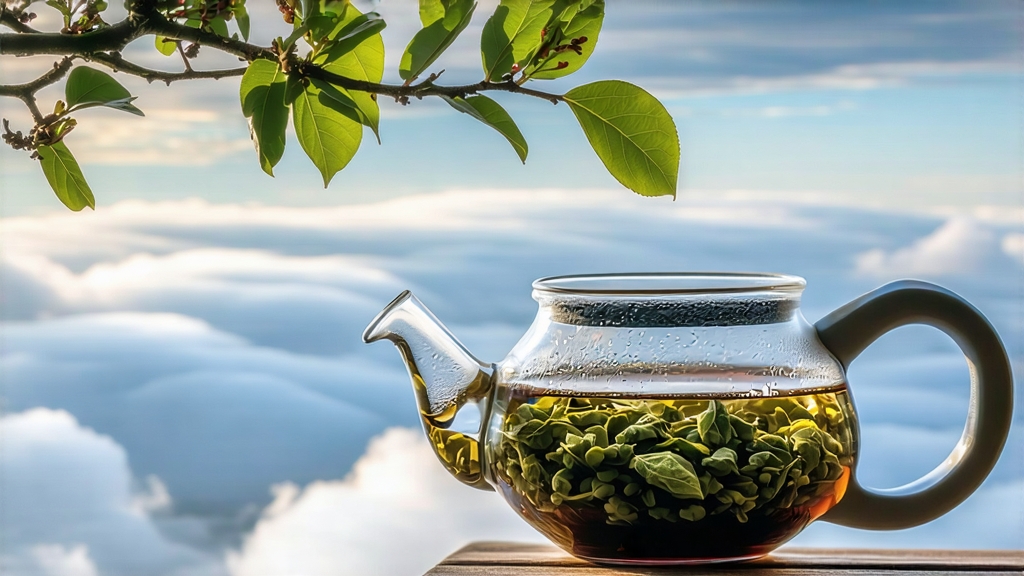
Rising like a jade island from the Tropic of Cancer, Taiwan’s Alishan range catches moist Pacific air and condenses it into a perpetual veil of mist. Between 1,000 and 1,400 metres above sea level, the tea gardens sit just below the cloud line, where daytime temperatures hover around 20 °C and plunge ten degrees at night. This thermal swing slows leaf growth, thickens cell walls and concentrates fragrant oils—natural gifts that give Alishan High-Mountain Oolong its signature “high mountain qi” (gaoshan yun): a cool, lilting bouquet that reminds drinkers of orchid, alpine milk and fresh-cut cucumber.
Historical roots
Oolong reached Taiwan in the mid-nineteenth century when Fujianese immigrants carried Qingxin (Green Heart) cuttings across the strait. Alishan itself remained a Tsou aboriginal stronghold until the Japanese colonial government (1895-1945) opened logging railways and mapped the slopes for horticulture. Post-war, retired soldiers of the Kuomintang were granted mountain plots; they grafted Qingxin onto seedling rootstocks, terraced the misty ridges and, by the 1980s, had turned “Alishan Oolong” into a luxury brand that eclipsed the older lowland teas of Taitung and Taipei. Today the name is protected: only leaves harvested within the townships of Meishan, Zhuqi, Fanlu and Alishan itself may bear the label.
Cultivar and micro-ecology
The dominant cultivar is still Qingxin Oolong, a shy-bearing bush with small, serrated leaves that absorb nitrogen slowly, producing more amino acids and less tannin. Under the forest canopy farmers maintain 30 % shade by inter-planting Taiwania cypress and bamboo; their fallen needles acidify the soil to a pH of 4.2–4.8, unlocking iron and magnesium that translate into a silky, mineral finish. Spring flushes arrive in late March after winter dormancy; winter flushes are picked in mid-October when northeast monsoons thicken the cuticle and intensify aroma. Between these two seasons lies a lighter “spring tail” harvest prized for its delicacy.
Plucking standard
Altitude forbids mechanisation, so every leaf is hand-plucked at dawn when dew still weighs the shoots. The standard is “one bud, three leaves” rather than the two-leaf norm of lower elevations; the extra mature leaf contains terpene precursors that survive the long withering to come. Pickers wear bamboo baskets lined with banana leaf to prevent bruising, and deliver the harvest to the mountain factory within two hours—any longer and the cool mountain air would start uncontrolled oxidation.
Crafting the semi-fermented leaf
Alishan Oolong is typically 20–30 % oxidised, lighter than Dong Ding but darker than modern “green oolongs.” The craft unfolds in six stages:
- Solar withering: leaves are spread 3 cm thick on bamboo trays and sun-wilted for 20–30 minutes until the edges feel leathery. UV light triggers lipoxygenase, generating floral lactones.
- Indoor withering and tossing: trays rest on racks for six hours while artisans toss the leaves in circular motions every hour. This gentle bruising ruptures 5 % of cells, allowing catechols to meet polyphenol oxidase and create the peach-hued rim that cuppers prize.
- Fixation: a 260 °C drum roast for three minutes kills enzymes, locking in the pale jade centre while preserving aromatics.
- Rolling: the hot leaves are wrapped in cotton cloth and rolled into hemispherical nuggets under mechanical pressure; cell sap coats the surface, ready to release flavour in the first steep.
- Drying: 80 °C hot air reduces moisture to 5 %, stabilising the leaf for mountain transport.
- Charcoal finish: traditionalists give the tea a 40-hour low-temperature bake over longan charcoal, adding a whisper of smoked honey that rounds the high notes. Modern “light aroma” versions skip this step, emphasising crisp florals instead.
Grading and styles
Auction graders evaluate Alishan Oolong on four metrics: aroma intensity, liquor brightness, leaf integrity and yun (after-impression). Top lots fetch over USD 1,000 per kilogram and display “white frost”—a talcum-like precipitate of amino acids that appears when the leaf is heavily shaded